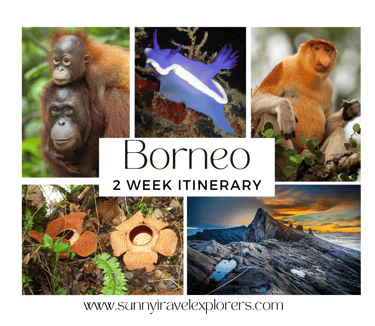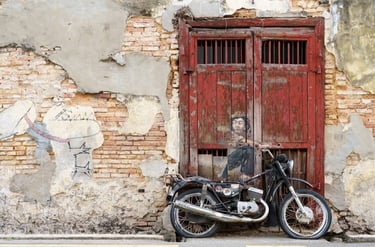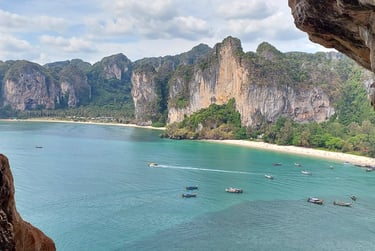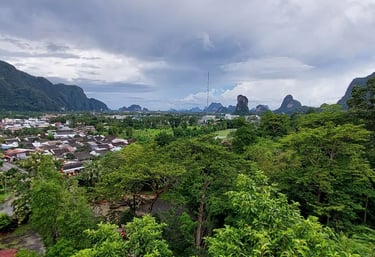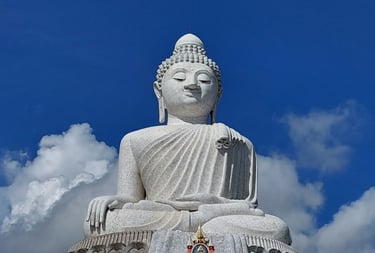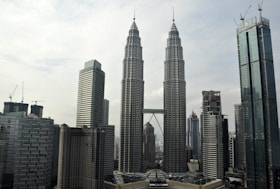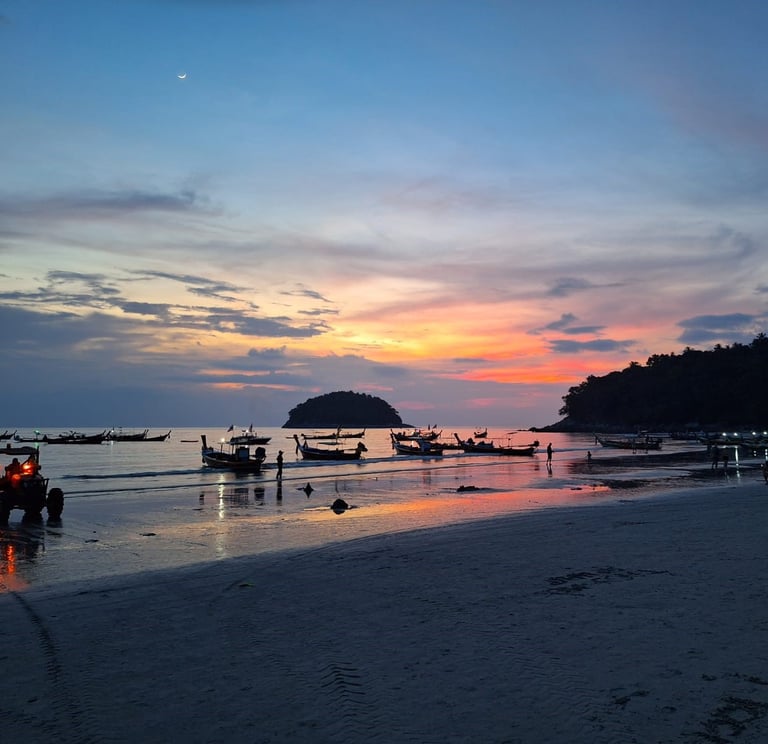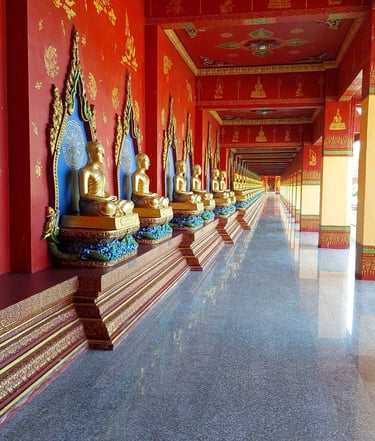
By Nom - 2 January 2025
Borneo Itinerary: Perfect 2 Week Adventure & Wildlife Guide
With its awe-inspiring landscapes, diverse ecosystems, wildlife and vibrant cultural experiences, Borneo promises an unforgettable journey for those ready to explore this gem of Southeast Asia.
Borneo is famous for serious adventure and getting close to extraordinary wildlife.
The rainforest here is estimated at 130 million years old and is one of the oldest in the world providing a haven for biodiversity and a kaleidoscope of flora and fauna, including the Rafflesia, the world’s largest flower and the iconic Orangutans which are only found in the rainforests of Borneo and Sumatra.
There are 200 different ethnic groups and indigenous tribes residing in Borneo such as the Iban and Dayak. Visitors can witness traditional dance performances, partake in authentic longhouse visits and savour local delicacies that showcase the rich culinary heritage of the island. The bustling markets and lively street scenes in cities like Kota Kinabalu and Kuching provide a perfect blend of urban charm and traditional charm.
A Sabah Itinerary offers a brilliant choice of activities from climbing South East Asia’s highest mountain – Mount Kinabalu to river tours to spot wild Orangutans and World class scuba diving.
Borneo is the third largest island in the world and it is politically divided between three countries; Malaysia, Brunei and Indonesia.
Borneo is a true paradise for adventurers and nature enthusiasts alike.
Given the size of Borneo you need to do your homework and plan your trip carefully. Don’t expect to get too far on a 2-3 week trip, so don’t try to overload your Borneo Itinerary.
Our Borneo Itinerary covers just 2 weeks in Sabah, the most northerly state of Borneo. Sabah and Sarawak belong to Malaysia and both have a much better infrastructure than the large southern Indonesian state of Kalimatan. Sabah is easier to travel around and ideal if you’ve only got 2-3 weeks for your Borneo Itinerary.


Borneo 2 Week Itinerary At A Glance
Kuala Lumpur – Kota Kinabalu – Tawau / Mabul – Sandakan – Kuala Lumpur
You can also reverse the itinerary:
Kuala Lumpur – Sandakan – Tawau / Mabul – Kota Kinabalu – Kuala Lumpur
You can of course add days to this itinerary outline to move at a slower pace and take in more that Borneo has to offer. Once you have made the decision to go, make sure you book your activities in advance as climbing Mount Kinabalu, diving at Sipadan Island and Turtle Island all require a permit and there are only a limited number available daily.
Do you want to read this later? Save this PIN on your Malaysia Board on Pinterest and read it later.
Reversing the trip ending with climbing Mount Kinabalu at the end is a great idea if you would prefer to rest for a couple of days afterwards.
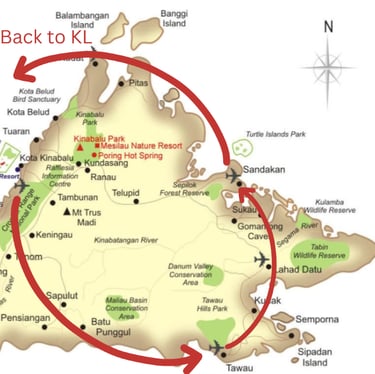

Our 2 week Borneo Itinerary started in Kota Kinabalu, capital of the state of Sabah. Kota Kinabalu is a large city and a great base from which to explore Sabah further.
Then we travelled to Sipadan, Mabul and Kapalai for World class scuba diving.
Borneo Itinerary - 2 Weeks Of Adventure
Next stop was Sandakan where we visited the Sepilok Orangutan Rehabilitation Centre where Orangutans that have sadly lost their habitat are taken care of. Then we took an overnight trip out to Turtle Island - Palau Selingan to watch turtles laying their eggs and learned more about the importance of Turtle Conservation. Our last adventure was cruising the mighty Kinabatangan River on the lookout for exotic birds, Pygmy Elephants, Crocodiles, Orangutans and Borneo’s other famous residents, Proboscis Monkeys.
If you have time to extend your itinerary we would recommend adding 3D2N at Danum Valley Conservation Area, one of the world’s most complex eco-systems with a towering 70m high canopy, home to some of the oldest dipterocarp rainforest in the world. Danum Valley Conservation Area is one of the best places in Borneo to visit if you’re a serious naturalist.
Contents:-
This 2 week Borneo itinerary starts and ends in Kuala Lumpur.
If you are travelling from the United Kingdom you can book a flight direct to Kuala Lumpur from London. You can then book separate flights over to Borneo and back allowing for a couple of days sightseeing in Kuala Lumpur at either end.
Getting to Borneo Kota Kinabalu
Kota Kinabalu is an easy two-and-a-half-hour flight from Kuala Lumpur. You can also do this itinerary in reverse by flying into Sandakan first which is three hours from Kuala Lumpur.
Kota Kinabalu is the capital city of the state of Sabah and the gateway to beaches, rainforests, watersports and so much more. It’s a good place to shop if you plan to climb Mount Kinabalu and need to stock up on warm weather gear or hiking boots if, for example, you’ve been travelling through Asia.
Getting to Kota Kinabalu
Add 1-2 days here if you want to explore Kota Kinabalu or if you want to rest after climbing Mount Kinabalu.
Getting around in Kota Kinabalu and Borneo is easy using the Grab app. Get a local SIM and you can travel all over the city easily and cheaply.
Where to Stay in Kota Kinabalu
For a ‘splash the cash’ option stay at the 5* highly rated Shangri-La Tanjung Aru Resort & Spa, or for a comfy low-key stay with all you need, choose Homy Seafront Hostel.
We stayed at the Kinabalu Daya Hotel for its convenient location close to the Saturday Night Market and Sunday Gaya Street Market. The Suria shopping Mall was only a 3 minute walk away which was convenient for stocking up on snacks and we bought our head torches and extra hiking socks here for climbing Mount Kinablau. The rooms and are clean and comfortable and they happily stored our extra luggage while we were away for 1 night on Mount Kinabalu.
Get Stuck into Local Cuisine
Kota Kinabalu is filled with busy streets, local eateries, shops and markets. What makes Malaysia unique is the fusion of Indian cuisine. The simple Roti Canai is a delicious no-frills dish, our personal go-to for a tasty snack.
Climbing Mount Kinabalu
The main reason most people visit Kota Kinabalu is to climb the famous Mount Kinabalu, the tallest mountain in Malaysia with a peak of 4095m. Climbing Mount Kinabalu is worth the effort and summiting this peak at sunrise will be one of the highlights of your Borneo trip.
You cannot climb Mount Kinabalu independently, you must obtain a permit from a local travel operator as Sabah Park only issue 163 permits daily. A climb slot is essentially a bed in Panalaban that comes with a climbing permit. The number of beds available corresponds to the number of climb permits issued.
Once you have decided to climb, it is advisable to book in advance. During peak season (May to August), it is recommended to book 4-6 months in advance for the Regular Descent and 2-3 months for Via Ferrata. In the off-peak season, it may be sufficient to provide 1-2 months' notice.
The dry season March to August is considered to be the best time to climb and try to avoid the monsoon season December to January.
Specialized mountain climbing skills such as rock climbing are not required to climb. Climbing Mount Kinabalu can be compared to ascending a continuous staircase, as long as you are relatively healthy and in good physical condition, you can confidently undertake the climb. It is advisable to engage in some regular exercise or training, particularly if you are a beginner or a novice hiker, as this can provide an extra advantage in achieving a successful ascent.
If climbing Mount Kinabalu is not for you or you couldn’t get a permit, it is still worth putting Kinabalu National Park on your Sabah itinerary as there are many other trails around the base which showcase some of the best primary rainforest in the world, many of which are easy and short enough for young kids to enjoy.
You may choose to add a few days post-climb to rest and recover, chilling out at the beach or diving. Remember you can always reverse our itinerary so that Mount Kinabalu is the last part of your adventure.

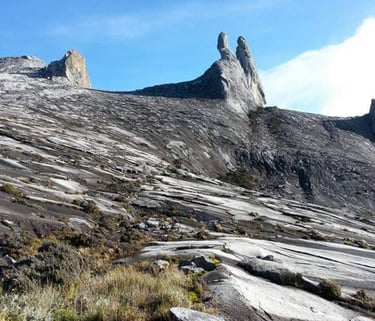
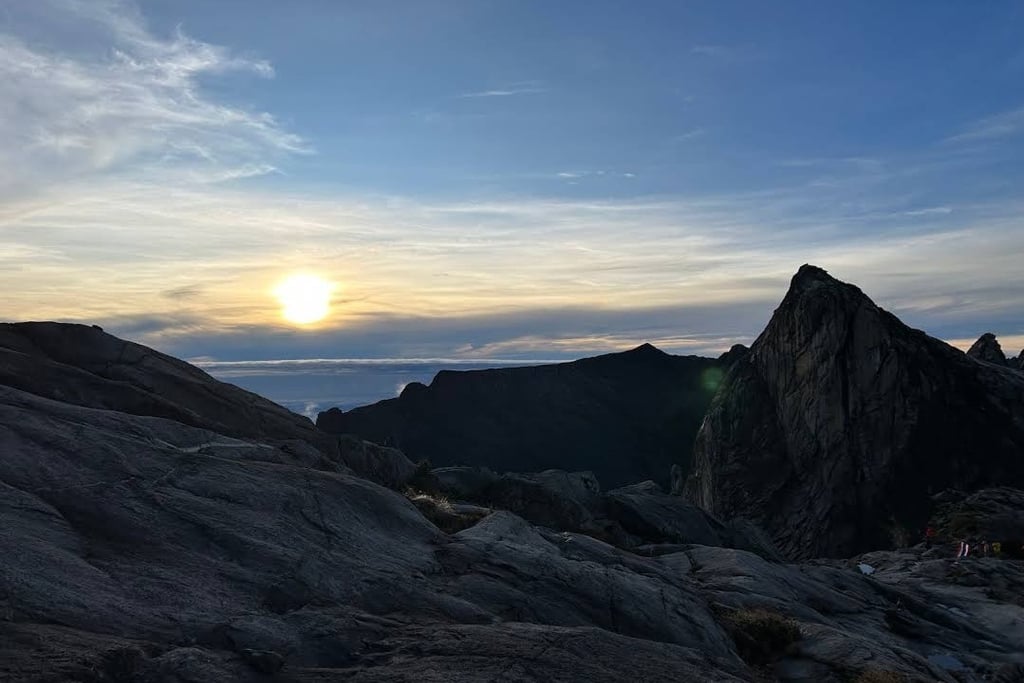

Read our Complete Guide to climbing Mount Kinabalu here
Other Kota Kinabalu Activities
Borneo is home to the world’s largest flower, the rafflesia.
However, it only grows in a few locations and one of the best places to see them in bloom is near Poring, a short drive from Kinabalu National Park.
We took a private taxi from Kota Kinabalu to Poring to spot one. Local taxi drivers will know the current whereabouts of a flowering rafflesia. Expect to pull up to a roadside shack advertising the flowering. You’ll pay a small viewing fee per person and take a short walk into the forest to see this incredible flower.
We then visited the Poring Hot Springs with the canopy walk. The canopy walk was fun and the springs were OK. If time is short we would recommend skipping the Poring Hot Springs.
You could add a day trip here to snorkel or dive the tropical waters of Tunku Abdul Rahman Marine Park and see a host of colourful reef fish and coral gardens.
Or try white water rafting Kiulu River, a fantastic Level 1-2 activity, ideal for families, friends, and couples seeking a thrilling experience together.
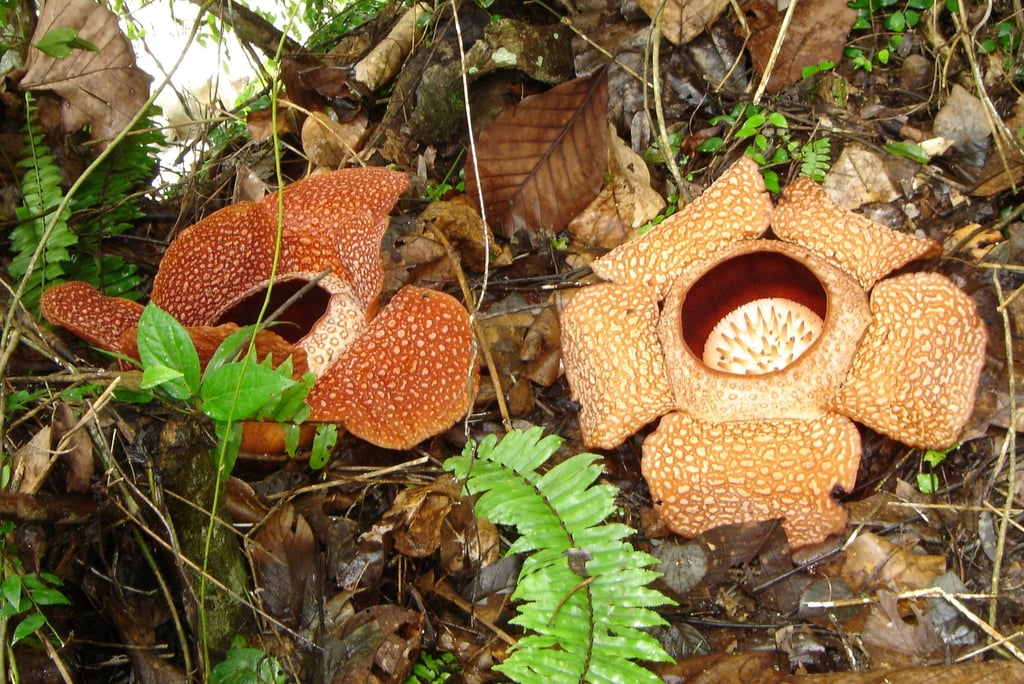

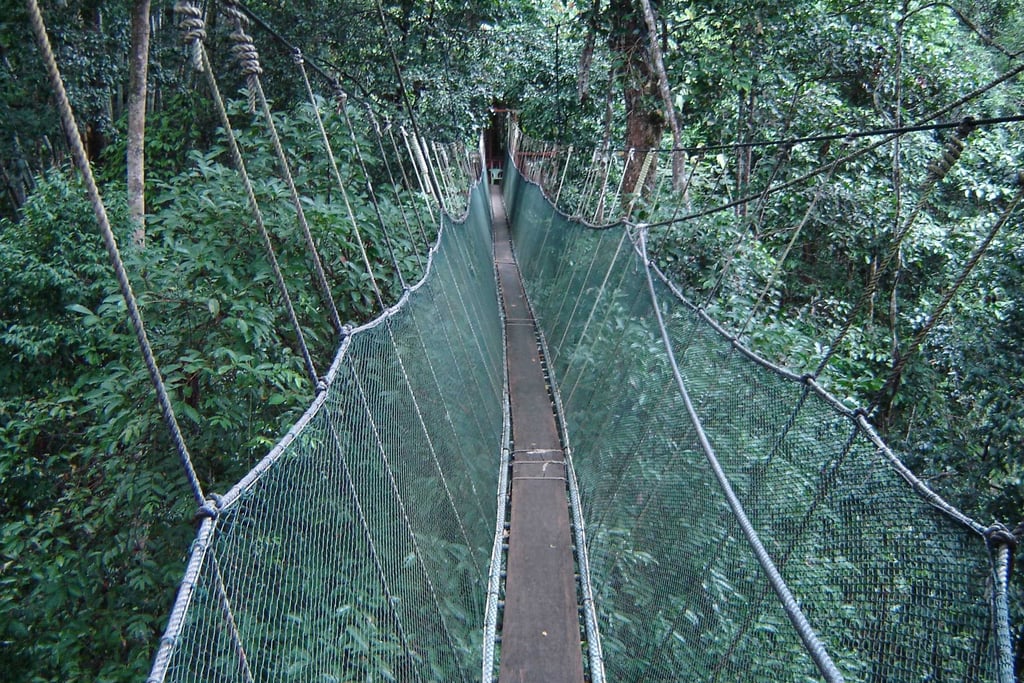

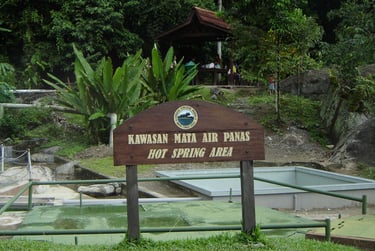

Fly Kota Kinabalu to Tawau
Get ready for an early start, the Air Asia flight to Tawau departs at 06.30 and takes 55 minutes. On landing it is a 1.15 hour transfer to Semporna Pier the gateway to Sipadan and Mabul Islands.
Semporna, a couple of hours south of Lahad Datu is the port town destination that attracts divers from all over the world to access the islands of Sipidan and Mabul. If you’re an avid diver, one of the best things to do in Borneo, will be to dive here as Sipidan Island is arguably one of the world’s best dive sites.
To protect the fragile reef, visitors are no longer permitted to stay on Sipdan Island and only 120 diving permits per day are issued for divers to dive around it. If you are on a 2-3 day diving package you can expect to have only 1-2 dives at Sipadan, the rest will be around Mabul & other dive sites.
Accommodation around Sipadan ranges from upmarket resorts or basic dive operations on Mabul Island or more affordable accommodation in less desirable mainland Semporna. If you can afford to splash out staying on Mabul Island will save you the often very rough daily boat trip from Semporna to Mabul.
We chose to dive with Borneo Divers and stayed at their Mabul Island Dive Resort. Our transfer from Tawau airport to Mabul Island was included in our package. We hired complete sets of equipment at an additional fee as we were only travelling light with only our masks, fins, snorkels and dive computers. We stayed for 3 nights and enjoyed the most spectacular diving.
See our blog here about diving Sipadan with Borneo Divers.
At the end of our package we were transported back to Semporna Pier. We then chose to spend the night in Tawau and enjoyed some delicious local food while off gassing.
The next day we took a 40 minute flight from Tawau to Sandakan with Malaysian Airlines.
You could add a 3D2N at Danum Valley Conservation Area here. Danum Valley is one of the world’s most complex eco-systems with a towering 70m high canopy, home to some of the oldest dipterocarp rainforest in the world. Danum Valley is one of the best places in Borneo to visit if you’re a serious naturalist.
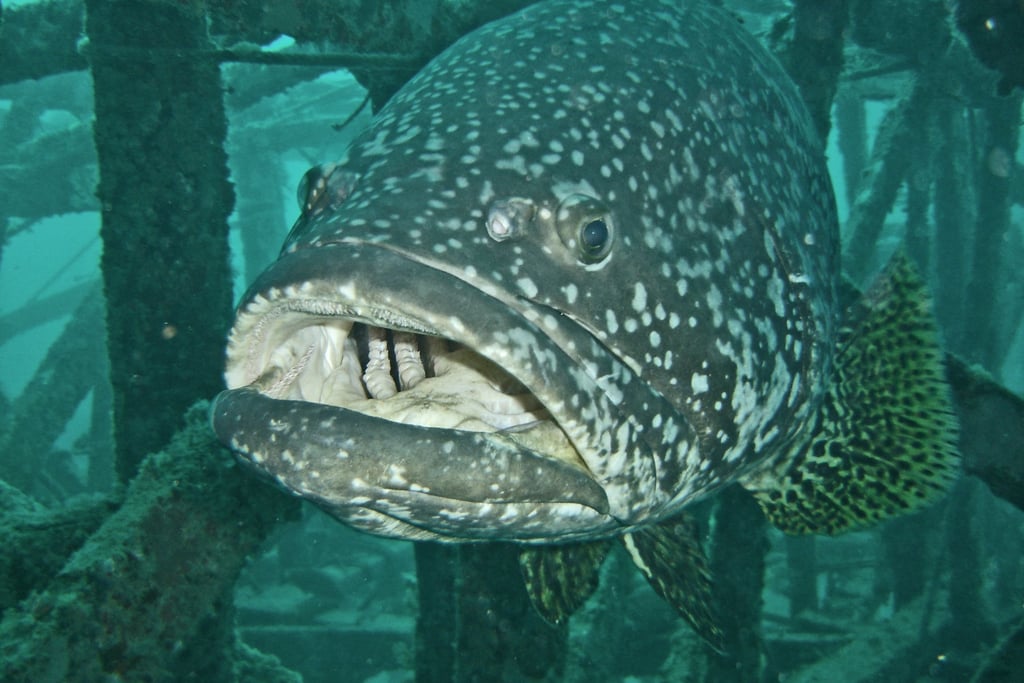

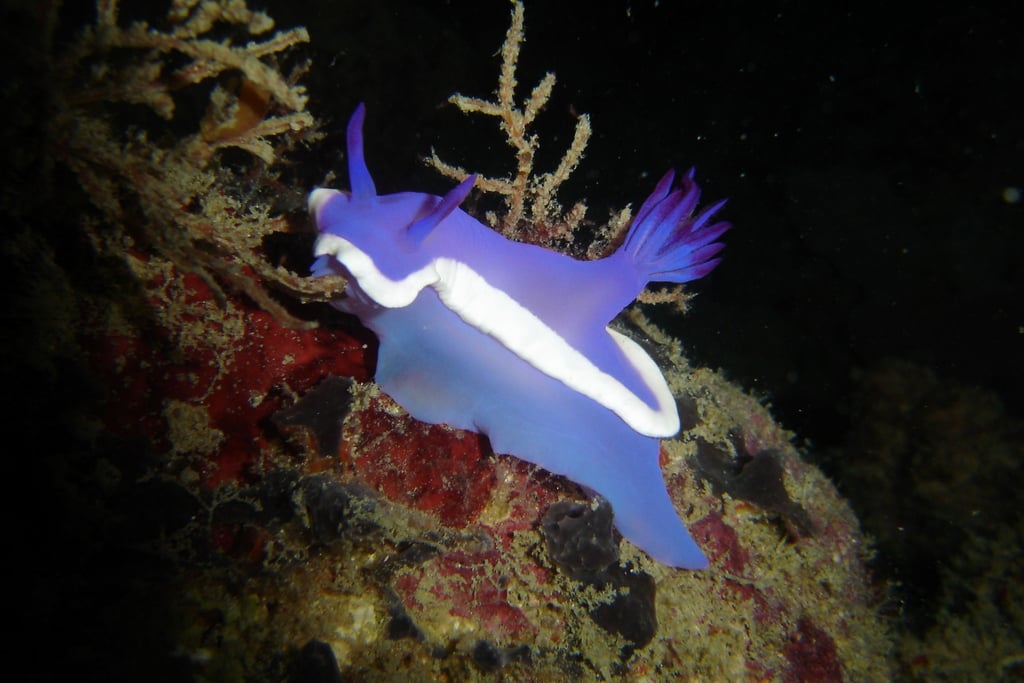

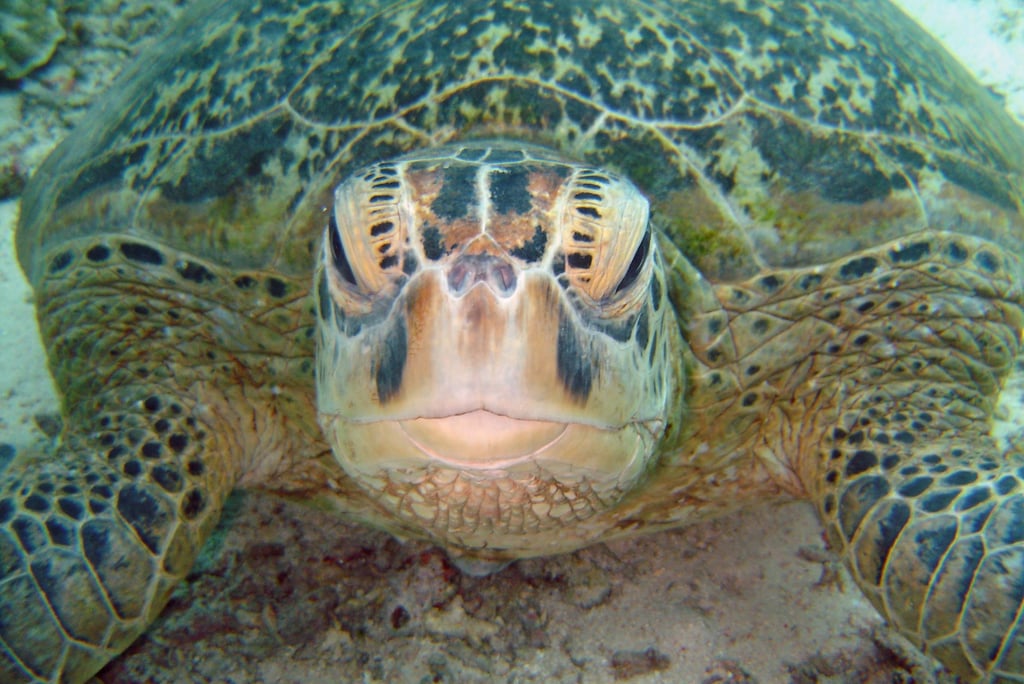

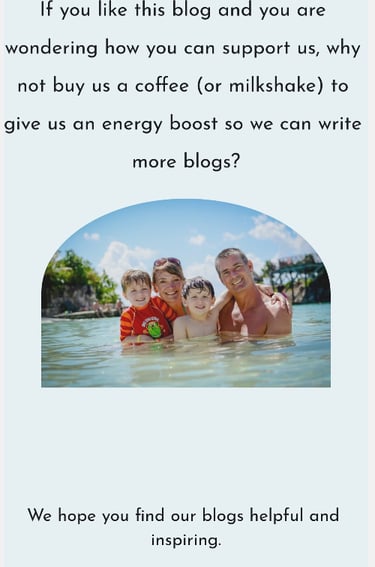

Sandakan
The second largest city in Sabah and the gateway to Sepilok, Turtle Island and the Kinabatangan River.
Sandakan is not a particularly attractive city after being bombed almost entirely in WWII. Many visitors choose not to stay in Sandakan, flying in and then travelling directly to Sepilok (30 mins in a taxi) to visit the world famous Sepilok Orangutan Rehabilitation Centre or straight to the Kinabatangan River (2-3 hour drive)
The city itself has few points of interest apart from colonial sights such as Agnes Keith’s house (a 1930’s famous American writer who wrote Land Below the Wind). There’s a pleasant English tea garden next door to the house, which is now a museum, which gives a good view over the city.
We landed and went straight to the Sepilok Orangutan Rehabilitation Centre to catch the 15.00 feeding session and then returned to spend one night in Sandakan before travelling to Turtle Island - Palau Selingan the next day.
Where to stay in Sandakan -We stayed at the conveniently located Hotel Sandakan which was close to shopping malls and the Sandakan Heritage Trails. The rooms are clean and comfortable and have everything you need for a quick sleepover.
If you’re on a budget, head for Borneo Sandakan Backpackers (around £14 for a double). For middle of the range, go for OYO 1030 Nak Hotel which has the best views from it’s very cool roof top terrace bar. This bar is open to non-residents so even if you’re staying elsewhere, it’s a good spot to have a cocktail (£5) and great pizza (£5 – the kids loved them!) and watch the sun go down.
If you have more time you can slow the pace here and opt to stay in Sepilok instead of Sandakan.
You can also add time to wander around the atmospheric Kampong Buli Sim Sim, a traditional stilt village 3km out of town easily reachable by a taxi or Grab. Locals come here to haggle over fresh and dried fish and to dine at the likes of Sim Sim Restaurant.
Where to Stay in Sepilok
For a night of indulgence choose Sepilok Nature Resort or you might prefer a traditional long house at Paganakan Dii Tropical Retreat which we would highly recommend. Tucked away in the jungle, it’s only a short (but not walking) distance to the Sepilok Orangutan Rehabilitation Centre.
The Sepilok Edge Lodge is another beautiful stay amongst the trees. Their food is amazing with some great veggie and vegan options. The lodge is only a ten-minute walk from the Orangutan Rehabilitation Centre. There’s a beautiful nature walk where you can spot monkeys, rainforest birds and creatures
Sepilok Orangutan Rehabilitation Centre
Don’t miss a visit to this iconic conservation hub which has successfully released rehabilitated Orangutans back into the wild since 1964. Visitors can watch released Orangutans returning back to the feeding platforms twice a day.
Aside from the nursery area, where you can see the babies with their carers through a glass viewing area, this is an open rainforest area where the Orangutans are free to roam. Food is left every day for those wanting to supplement their food from the wild, however, the Rangers leave the same food (so they become bored with it) to encourage the Orangutans to rely on natural food sources in the rainforest.
Don’t expect to see lots of Orangutans. The Orangutans that come to feed, are now wild – released Orangutans that have worked their way through the comprehensive rehabilitation programme (sometimes 16 years long!) and choose to return for feeding sessions. We had seven Orangutans come to the feeding station during our visit and it was magical.
Sepilok is for Orangutan rehabilitation, not providing entertainment for visitors, so don’t expect to be able to pick up baby Orangutans. You have the opportunity to adopt an Orangutan for around £30 a year for which you will receive photographs and updates throughout the year. Money well spent and a great way to support this fantastic cause.
TIP: Feeding sessions are at 10.00 and 15.00. Tour buses packed full of tourists arrive and go straight into the Education Centre to watch a 20 minute film about the Orangutans. By-pass the film and go straight to the feeding platform – you’ll be the first there and will bag a front side view. After the film ends the feeding platform can be 8-9 people deep with limited viewing from the back. After the feeding session, go back and watch the film which is re-played regularly.


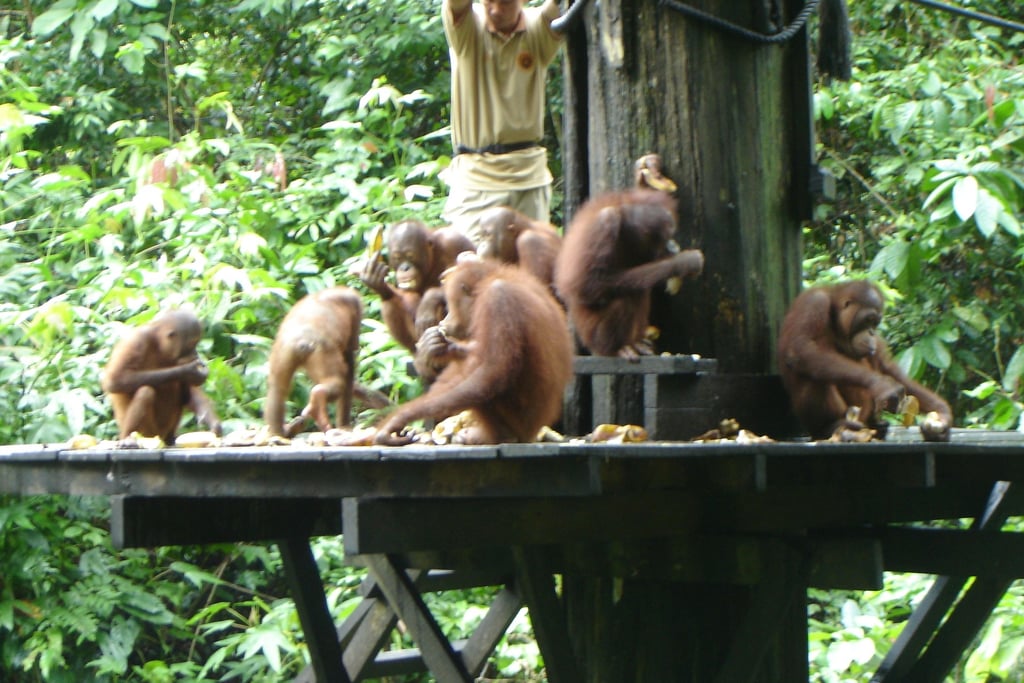

Borneo Sun Bear Conservation Centre
After your visit to the Sepilok Orangutan Rehabilitation Centre, we would highly recommend taking the time to visit the Sun Bear Conservation Centre which is literally next door. This incredible centre has been instrumental in keeping the Bornean Sun Bear from the brink of extinction. The Founder, Dr Wong, has earned a raft of international awards and recognition for his conservation efforts.
Following the Sepilok Orangutan Rehabilitation Centre we returned to Sandakan for one night before our next morning departure to Turtle Island - Palau Selingan, a National Marine Park where we stayed overnight to witness mother turtles nesting and baby turtles being released under the National Park Conservation Project.
Turtle Island – Palau Selingan
Palau Selingan is one of three islands (Selingan Island, Bakungan Kecil Island, and Gulisan Island) making up the Turtle Islands National Park in the Sulu Sea.
Palau Selingan is the only Island visitors are permitted on and has one of the best turtle hatchery sites in Malaysia. A visit here is guaranteed to be a highlight in your Sabah itinerary.
The peak nesting months of sea turtles are from April to August, but turtle landings occur almost every day. Green Turtles and Hawsbill Turtles are the most frequent landings and you can observe totally wild mother and baby turtles up-close.
The Conservation Centre has been conserving turtle since 1977 and successfully saved thousands of turtles. The Rangers move the freshly laid turtle eggs to a protected hatchery for a better survival rate. Once the baby turtles are hatched, they are released back into the sea.
The only way to visit Turtle Island is by booking a 2D1N tour direct through Crystal Quest or more expensive tour operators (who buy direct from Crystal Quest). Booking from abroad is tricky. Read our full guide to how to book and what to expect on the Turtle Island tour here in our Ultimate Guide to Visiting Palau Selingan.
Make sure to pre-book this 2D1N trip as visitors are limited to 50 per night so there is normally no last-minute availability.
Watching the Rangers releasing the baby turtles and seeing them flap their way to the ocean remains etched on our memories forever – a definite highlight of our Borneo itinerary!
The next morning, we transferred back to Sandakan and straight onto a 3D2N Kinabatangan River Safari.
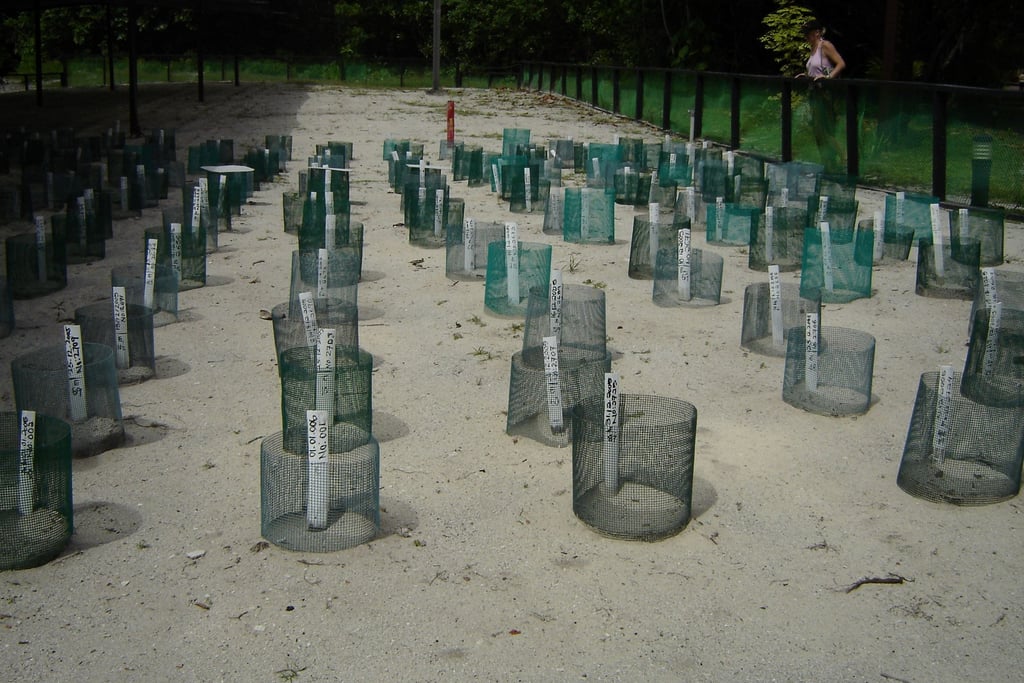

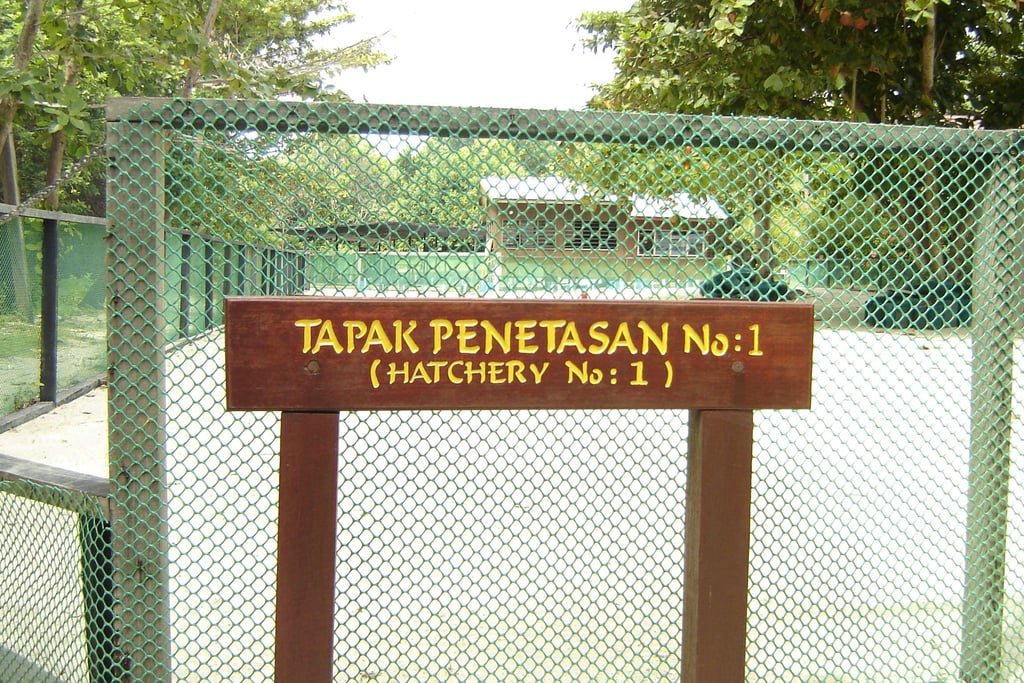

Kinabatangan River Safari 3D2N
A wildlife spotting trip to the Kinabatangan should definitely not be missed from your Sabah itinerary!
The Kinabatangan River, only a few hours drive from Sandakan, is one of the best places in Borneo to see wild Orangutans in their natural habitat. One of the most bio-diverse places on our planet, the Kinabatangan is one of only two places on earth where 10 species of primate are found.
Getting to The Kinabatangan River
You can arrange a visit to Kinabatangan River from anywhere in Borneo. Most Kinabatangan River lodges arrange pick up from the airport or Sandakan and include the 2-3 hour transfer in the tour price.
Where to Stay in Kinabatangan River
Most visitors stay in or around Sukau, a tiny village on the banks of the Kinabatangan. There are many accommodation providers dotted around the river from sumptuous eco river lodges or more basic, affordable accommodation.
We stayed at The Borneo Natural Sukau Bilit Resort. If there’s a time to splash out, it’s definitely here if you’ve got the cash. Sukau Rainforest Lodge is one of National Geographic’s top 30 lodges in the world and will provide an unforgettable stay on the river. The lodge has an onsite naturalist who gives plenty of talks and night walks and even has it’s own 440m boardwalk into the rainforest canopy.
A 3D2N stay included; The rainforest lodge, five river cruises, two night walks, one trek and all meals.
All lodge package rates should include wildlife tours (normally 2 boat tours a day). Often package tours are 3D2N which should allow you time to see an array of wildlife. Obviously the longer you stay on the river, the likelihood of wildlife sightings increase, however as ever with animals, no guarantee is given. If you have time in your Borneo itinerary, consider booking for longer here to partake in additional tours such as a night time boat tour or guided hikes.
For budget travellers, Osman’s homestay comes recommended (Osman is an excellent guide & they’ll happily put an extra bed in the room for kids for an extra 50RM (2-11) or 100RM for 12+).
Sukau Greenview is also a good, budget friendly option, just a short walk along the river from Sukau.
You can easily visit independently if you choose – it’s easy to hire a guide and stay in a local homestay.
This area is teeming with wildlife and we were hoping to spot the Borneo ‘Big five’:
1. Orangutans
2. Pygmy Elephants
3. Proboscis Monkeys
4. Crocodiles
5. Hornbills
We were very lucky to spot four, the Pygmy Elephants eluded us!
The encroaching palm oil plantations have driven wildlife to the banks of the Kinabatangan River which is now a protected area known as the ‘Corridor of Life’. Kinabatangan River Safaris are the best way to see wildlife here. The river is the main transport route due to the rainforest being largely inaccessible.
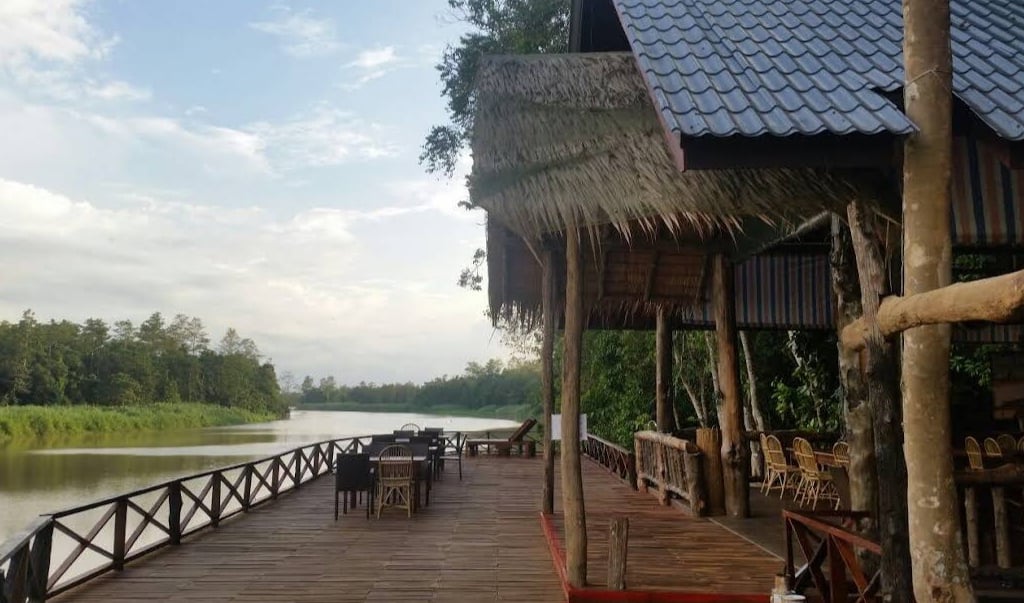


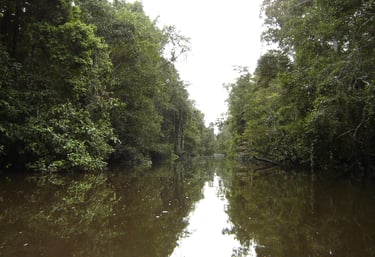
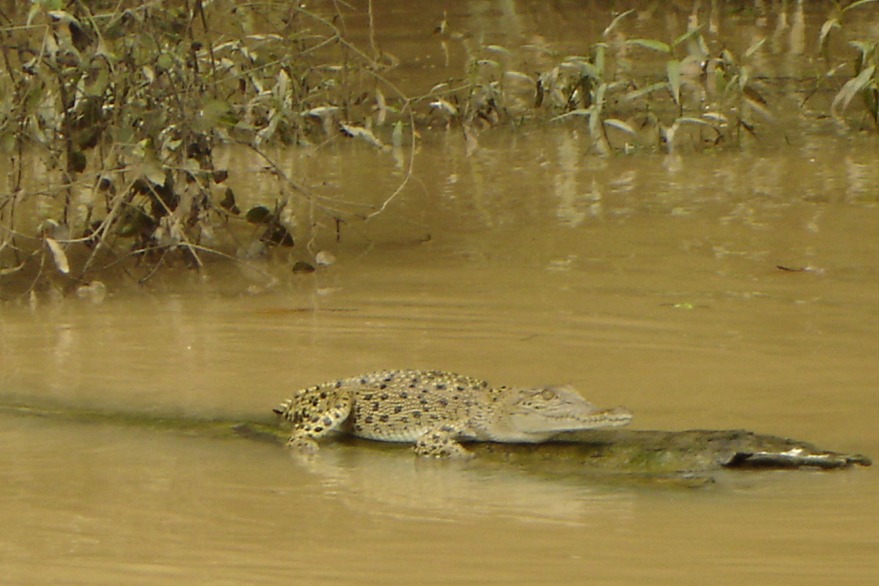

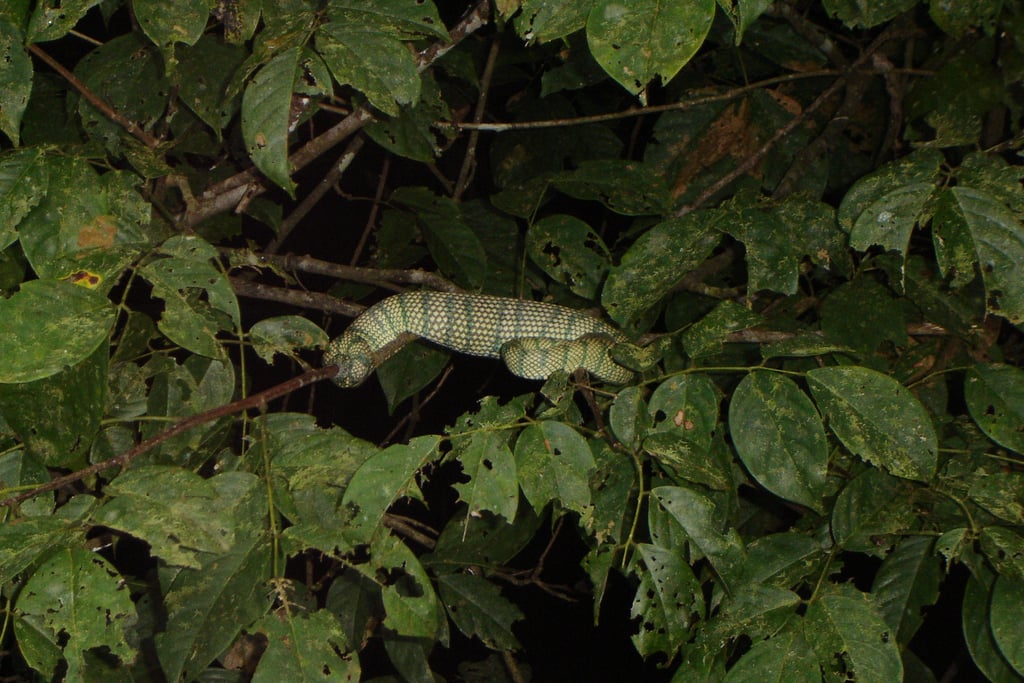

Sadly, that was the end of our Sabah itinerary and we returned to Sandakan for our direct flight back to Kuala Lumpur. If you have the time to move at a more leisurely pace you may choose to return overland by bus to Kota Kinabalu to take in the lush scenic countryside.


Danum Valley Conservation Area
Many visitors push deeper into the rainforest at the Danum Valley Conservation Area, one of the world’s most complex eco-systems with a towering 70m high canopy.
Lahad Datu, a small coastal town, is the gateway to the Danum Valley. All Danum Valley tours depart from Lahad Datu and you can fly directly here from Sandakan or Kota Kinabalu.
Home to some of the oldest dipterocarp rainforest in the world, Danum Valley is one of the best places in Borneo to visit if you’re a serious naturalist. It’s said, a new species of plant is discovered here every week.
A word of warning though, a stay in the Danum Valley does not come cheap, unless you are well prepared and book early with the Danum Valley Field Centre, an outpost for scientists and researchers. This is the reason we sadly couldn’t add it to our Borneo itinerary. There are only two lodging options in this jungle, the luxurious Borneo Rainforest Lodge or the rough and ready Danum Valley Field Centre. We will definitely be adding Danum Valley to our Borneo Itinerary next time.
Discover Our Other Guides
Phang Nga On A Backpacker Budget
Read Our
Malaysia Travel Blogs
Read Our
Thailand Travel Blogs


Note: This post contains affiliate links. When you make a purchase using one of these affiliate links, we get paid a small commission at no extra cost to you.
SUBSCRIBE
Subscribe to our newsletter to always be the first to hear about recent Blogs and adventures.

